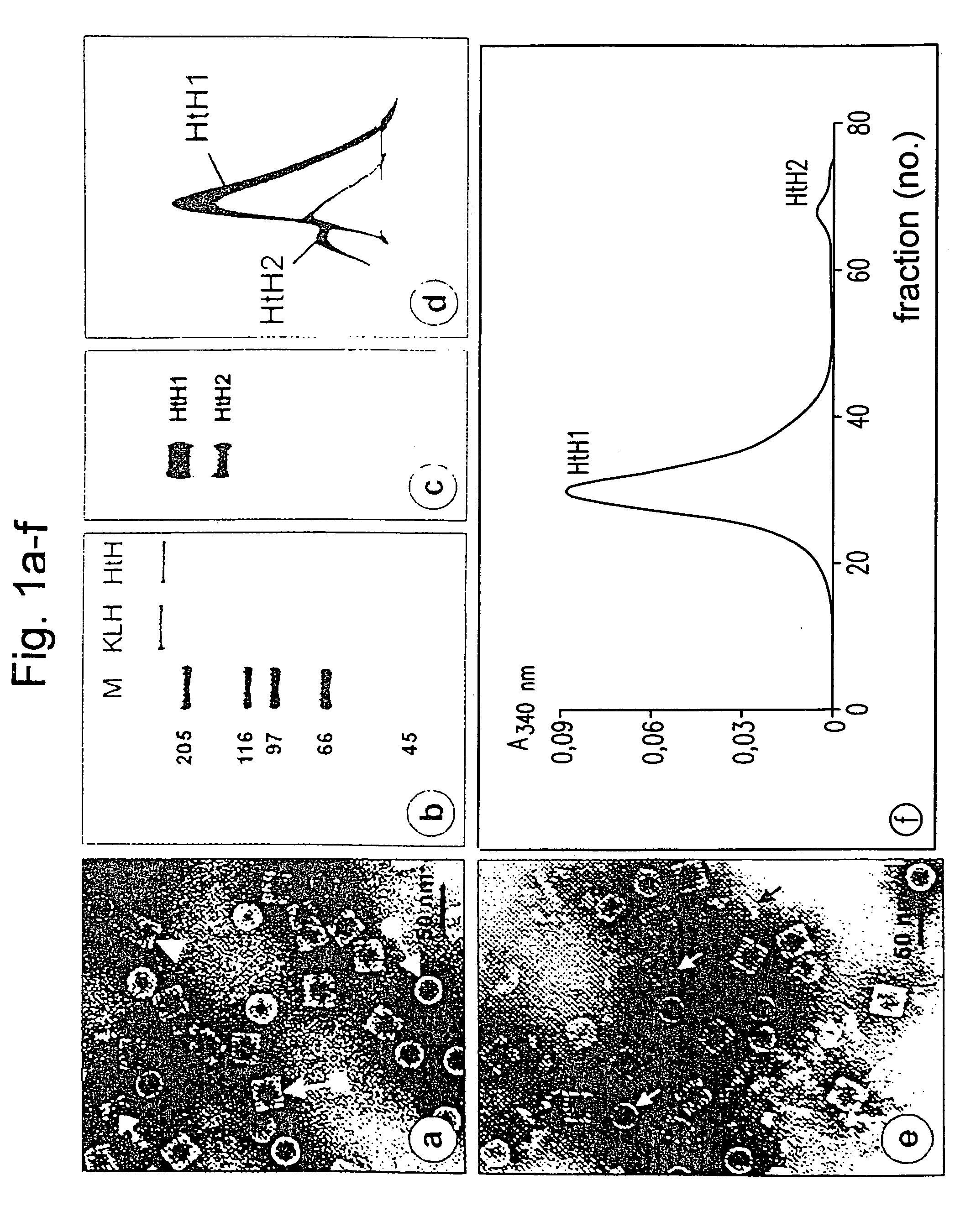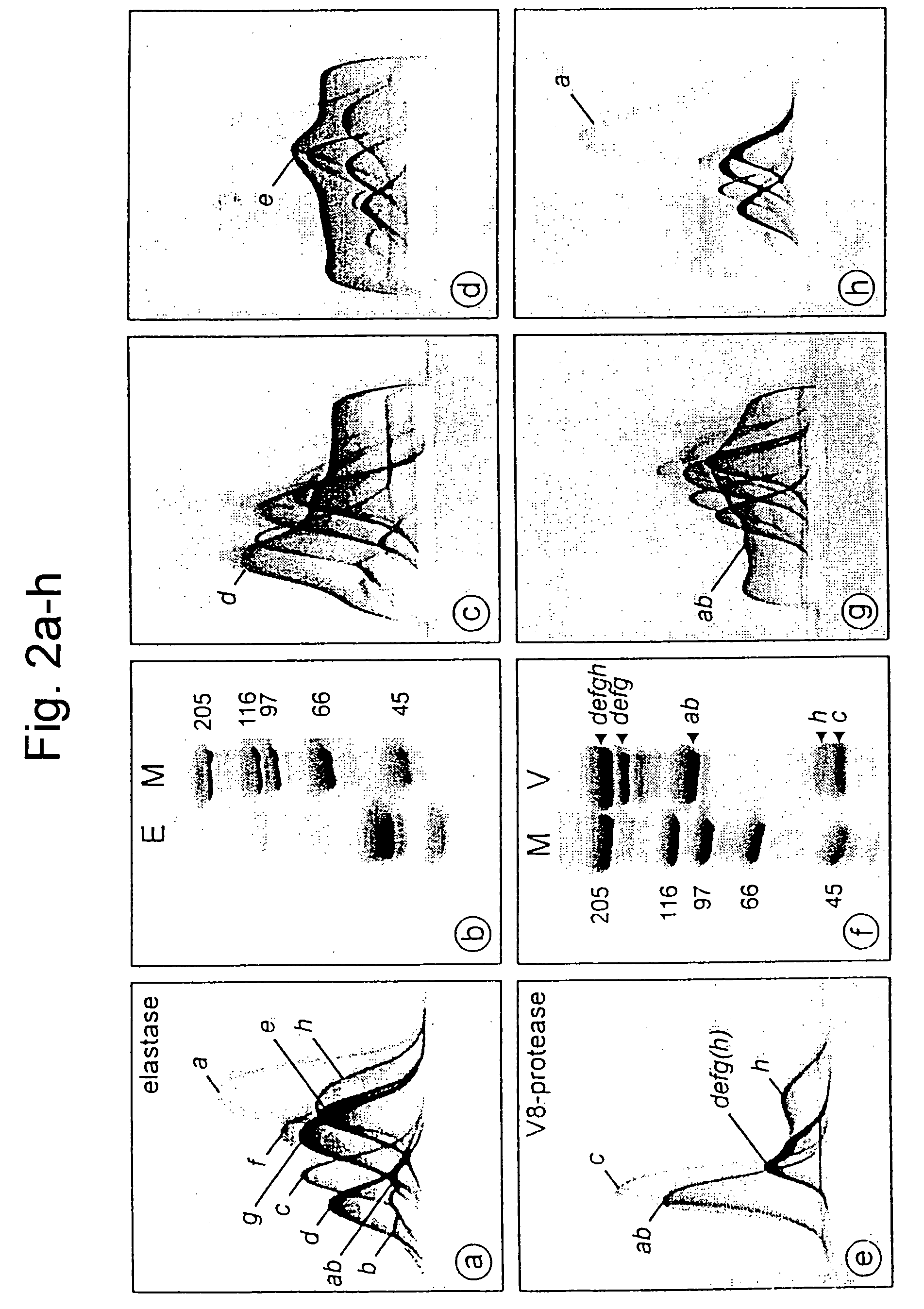Nucleic acid molecule comprising a nucleic acid sequence coding for a haemocyanin
a nucleic acid sequence and nucleic acid technology, applied in the direction of invertebrate antigen ingredients, peptide sources, non-active ingredients of pharmaceuticals, etc., can solve the problems of sequences that do not allow the design of sequence-specific primers and/or probes, and the immune system is not well understood. , to achieve the effect of avoiding the formation of a single nucleic acid sequence, it is not possible to clarify the primary structure, and the sequences tha
- Summary
- Abstract
- Description
- Claims
- Application Information
AI Technical Summary
Benefits of technology
Problems solved by technology
Method used
Image
Examples
example 1
Isolation of HtH and Separation of Two Different Types (HtH1 and HtH2)
[0230]The haemolymph was obtained from adult abalones. The blood cells were removed by centrifugation and the haemocyanin was then sedimented by ultracentrifugation. The blue haemocyanin pellet was dissolved again in “stabilization buffer” (pH 7.4) and examined by electron microscopy (FIG. 1a). It comprised mainly typical di-decamers, accompanied by a small content of decamers and tridecamers. Denaturing in 2% SDS in the presence of reducing substances and subsequent SDS-PAGE separation resulted in a single band, which corresponded to the polypeptide with an apparent molecular weight of 370 kDa, which is only slightly below the apparent subunit weight of KLH (FIG. 1b). Complete dissociation of the oligomers and of the di-decamers into the native polypeptides (subunits) was achieved by overnight dialysis of HtH against “dissociation buffer” (pH 9.6). The native PAGE method, which was used on these samples, showed a...
example 2
Analysis of the Organization of the HtH1 Subunit
[0232]The eight functional units (FUs, often called “functional domains”) which form a mollusc haemocyanin subunit differ in primary structure and show no immunological cross-reactivity, as emerged from crossed IE. In the case of the purified HtH1 subunit (FIG. 1g, h), small concentrations of five different proteases (elastase, V8 protease, papain, trypsin and chymotrypsin) which had cleaved the peptide bonds between adjacent FUs of KLH1 and KLH2 were used (Gebauer et al., 1994, supra, Söhngen et al., 1997, supra). The cleavage products were investigated by crossed IE and SDS-PAGE (FIG. 2). Elastase treatment produces eight individual FUs, deduced from the number of different immunoprecipitation peaks in the crossed IE (FIG. 2a) and with the apparent molecular weight of approx. 50 kDa of the main portion of the cleavage products in SDS-PAGE (FIG. 2b). A further precipitation peak was recognized as FU dimer, which was formed by incomple...
example 3
[0235]Comparison of the molecular weights and N-terminal sequences of the biochemically isolated functional units (FUs) from HtH1 and KLH1. The various FUs, each with an intact binuclear copper-binding site, were liberated from their larger unit as globular segments by limited proteolysis; cf. the section “Isolation and analysis of the units from HtH1”. The KLH1 data were obtained from Söhngen et al., supra. The assignment as an actual unit was done on the basis of the molecular weight and the immunological properties (cf. FIG. 2). The unusually low molecular weight of isolated HtH1-d could means that a large peptide was split off C-terminally.
[0236]
TABLE 1FunctionalWeightunit(kDa)N-terminal sequenceHtH1-a53 DNVVRKDVSHLTDDEVQKLH1-a50 ENLVRKDVERLHtH1-b48 ?KLH1-b45 ?HtH1-c46 FEDEKHSLRIRKNVDSLTPEENTNERLRKLH1-c45 KVPRSRLIRKNVDRLTPSEHtH1-d40 VEEVTGASHIRKNLNDLNTGEMKLH1-d50 EVTSANRIRKNIENLSHtH1-e49 ILDHDHEEEILVRKNIIDLSPKLH1-e50 ...
PUM
| Property | Measurement | Unit |
|---|---|---|
| molecular weight | aaaaa | aaaaa |
| diameter | aaaaa | aaaaa |
| diameter | aaaaa | aaaaa |
Abstract
Description
Claims
Application Information
 Login to View More
Login to View More - R&D
- Intellectual Property
- Life Sciences
- Materials
- Tech Scout
- Unparalleled Data Quality
- Higher Quality Content
- 60% Fewer Hallucinations
Browse by: Latest US Patents, China's latest patents, Technical Efficacy Thesaurus, Application Domain, Technology Topic, Popular Technical Reports.
© 2025 PatSnap. All rights reserved.Legal|Privacy policy|Modern Slavery Act Transparency Statement|Sitemap|About US| Contact US: help@patsnap.com



